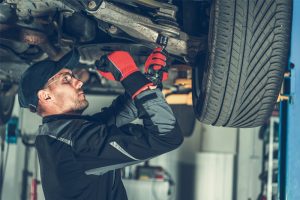Shock absorbers play a critical role in your vehicle’s safety, handling, and ride comfort. Whether your current shocks are worn out or you’re simply aiming to improve performance, you might be wondering: Should you replace them with OEM (original equipment manufacturer) parts or upgrade to high-performance alternatives?
Both options have their benefits, but the best choice depends on your driving style, vehicle type, and budget. This article breaks down the differences between replacing and upgrading shock absorbers so you can make an informed decision.
Why Shock Absorbers Matter
Before diving into the comparison, it’s important to understand the purpose of shock absorbers. These components:
-
Dampen spring oscillations after hitting bumps
-
Keep your tires in contact with the road
-
Control body roll, squat, and dive
-
Improve overall ride stability
Without properly functioning shocks, your car becomes difficult to handle, especially during braking, cornering, and rough-road driving.
Replacing Shock Absorbers: The Safe Bet

Replacing your shocks typically means using parts that match the vehicle’s original specifications — usually OEM or equivalent aftermarket components.
Pros of Replacing with OEM-Style Shock Absorbers:
-
Cost-Effective – Generally less expensive than performance upgrades
-
Reliable Performance – Matches the intended ride quality and handling
-
Straightforward Installation – No additional modifications required
-
Compatible with Other Stock Components – Springs, bushings, and mounts work as intended
When Replacement Is Ideal:
-
You use your vehicle primarily for commuting or city driving
-
You’re happy with the factory ride quality
-
You want to restore your vehicle’s original handling characteristics
-
Your existing shocks are worn out and need replacement
Upgrading Shock Absorbers: A Performance Boost
Upgrading your shocks means switching to higher-performance parts, like gas-charged, adjustable, or sports-tuned shock absorbers. These are often used in motorsports, off-roading, or for better everyday handling.
Pros of Upgrading Shock Absorbers:
-
Improved Handling and Stability – Especially noticeable in sharp turns and high-speed driving
-
Reduced Body Roll and Brake Dive – Enhances driver confidence
-
Customizable Options – Adjustable damping, ride height, or rebound rates
-
Enhanced Load Management – Ideal for towing or heavy-duty applications
When an Upgrade Makes Sense:
-
You enjoy spirited driving or track days
-
You’ve added performance tires, wheels, or springs
-
Your vehicle is used for off-roading, towing, or long-distance travel
-
You want a firmer or more responsive driving feel
Comparison Table: Replacement vs. Upgrade
| Criteria | Replace (OEM Style) | Upgrade (Performance) |
|---|---|---|
| Cost | $$ | $$$ – $$$$ |
| Ride Comfort | Factory standard | Tuned, may be stiffer |
| Handling | Balanced | Sharper and more controlled |
| Installation Complexity | Easy, plug-and-play | May require tuning or adjustments |
| Compatibility | 100% with stock components | Sometimes needs supporting parts |
| Ideal For | Daily drivers, budget-focused | Enthusiasts, heavy-use vehicles |
Key Factors to Consider
Before making your choice, ask yourself:
-
How do you drive?
If you mostly drive on highways or in urban settings, replacements are likely sufficient. If you drive aggressively or off-road, consider upgrading. -
What’s your budget?
Basic replacements are more affordable. Upgrades can be costly, especially for high-end brands or adjustable systems. -
What are your goals?
Do you want to restore your car’s original feel or significantly improve its cornering and responsiveness? -
Do you plan to modify other parts?
If you’ve installed stiffer springs, larger wheels, or a performance braking system, upgraded shocks will help balance the setup.
Costs: What You Can Expect
| Shock Absorber Type | Average Cost (per unit) |
|---|---|
| Basic OEM-Style (Hydraulic) | €30 – €80 |
| Gas-Charged or Twin-Tube | €70 – €150 |
| Performance Adjustable (Mono-tube or Coilover) | €150 – €400+ |
Remember to factor in labor costs if you’re not doing the installation yourself.
Mixed Approach: A Balanced Solution
Some drivers choose a mixed setup: basic replacements in the rear and performance shocks in the front, or vice versa. This can offer enhanced performance without full upgrade costs — though compatibility and ride balance should be carefully considered.
When to Upgrade and Replace Together

In some cases, replacing or upgrading the shocks isn’t enough — it’s wise to replace or upgrade supporting suspension components at the same time:
-
Springs
-
Strut mounts
-
Control arms
-
Bushings
A matched system delivers the best results and avoids premature wear of the new parts.
Where to Find Quality Shock Absorbers
Whether you’re looking to replace your shocks with OEM-style units or take your suspension to the next level with performance upgrades, choosing the right parts is crucial.
Buy Shock Absorbers online from a trusted supplier offering a wide range of options for all vehicle types and driving needs.
Final Verdict: Replace or Upgrade?
There’s no one-size-fits-all answer. Here’s a quick summary to guide your decision:
-
Choose Replacement if:
-
You want a reliable, cost-effective fix
-
Your driving is casual or moderate
-
You prioritize comfort and affordability
-
-
Choose Upgrade if:
-
You demand better control and handling
-
You’ve modified your vehicle for performance
-
You tow, haul, or drive in extreme conditions
-
Ultimately, the best shock absorber is the one that matches your vehicle, your road, and your lifestyle.